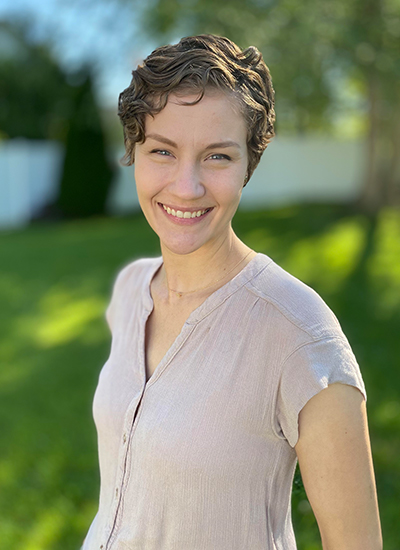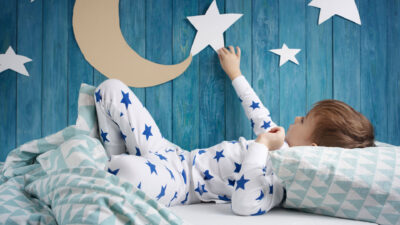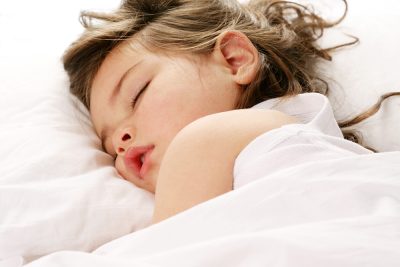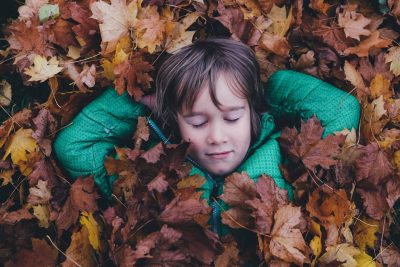Sleep Disorders in Children
- by Abby McCoy
- Updated: October 3, 2023
Table of Contents
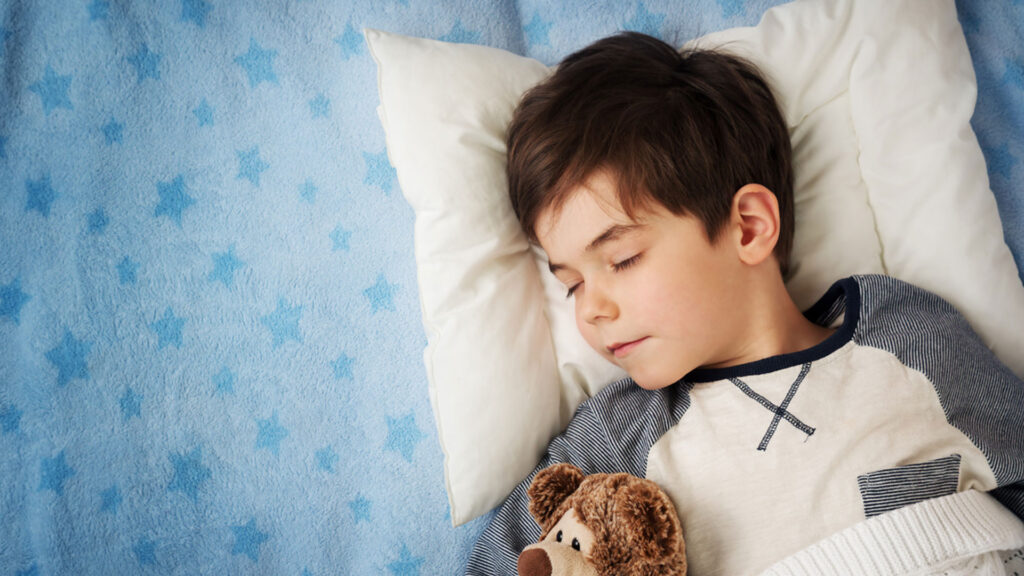
Most children hate sleep at certain points in their development — life feels too full of adventures, games, and delicious snacks to waste time sleeping! In J.M. Barrie’s Peter Pan, Wendy, Peter, and Michael’s canine nanny was trying to put them down for the night, but little Michael hollered, “I won’t go to bed!… I won’t, I won’t!” If you’re a parent or care for little ones, you may be nodding, and perhaps breathing a sigh of relief that you’re not the only one with this problem.
Though they don’t know it, children need more sleep than adults because their bodies and minds are growing at a breakneck pace. (1) So how can you tell if your kid is just excited to be alive or if they have a sleep disorder? We’ll lay out the most common sleep disorders in children below and let you know what you can do about them.
Note: The content on Sleepopolis is meant to be informative in nature, but it shouldn’t be taken as medical advice, and it shouldn’t take the place of medical advice and supervision from a trained professional. If you feel you or your child may be suffering from any sleep disorder or medical condition, please see your healthcare provider immediately.
Long Story Short
- Sleep disorders in children can be caused by an unpredictable bedtime routine, an uncomfortable sleeping environment, or other sleep disorders.
- Some common sleep disorders in children include night terrors, bedwetting, sleepwalking, insomnia, restless leg syndrome, excessive daytime sleepiness, and bruxism – or teeth grinding.
- You can help your child sleep better by establishing good sleep hygiene and by working with their healthcare provider to figure out what’s causing trouble sleeping.
What Causes Sleep Disorders in Children?
Sometimes temporary sleeplessness can linger, and you may notice your child isn’t quite themselves. “Children, like adults, can be susceptible to sleep disorders…such as insomnia, obstructive sleep apnea, and restless leg syndrome,” Dr. Peter G. Polos, MD, pulmonologist, sleep medicine physician, and associate professor of sleep medicine at Hackensack JFK Medical Center tells Sleepopolis.
On the other hand, Polos says, some sleep disorders show up a lot more in children than in adults, like sleep talking, sleepwalking, night terrors, and nightmares. Sleep disorders in children are typically associated with one or more of the following: (2)
- Chronic medical conditions
- Diet
- Genetic factors
- Inadequate sleep hygiene
- Medications
- Mental health issues
- Neurological conditions
- Obesity
- Stress/anxiety
Recognizing Sleep Disorders in Children
While the causes may be easier to identify, kids don’t always make their symptoms clear. “For example,” says Polos, “a child who is overly sleep deprived can [seem] overactive rather than sleepy as an adult might.” Overtired children may show symptoms like: (3)
- Hyperactivity
- Inattentiveness
- Irritability
- Difficulty regulating emotions
If your typically cheerful child is acting out more than normal or their teacher says that your kid is having trouble paying attention in school, one possible explanation could be lack of sleep. Let’s look at the different types of sleep disorders most often seen in children, and then we’ll get into some solutions.
Sleepwalking and Bedwetting
Sleepwalking and bedwetting are two types of sleep disorders that fall into the category of parasomnias. (4) (5) Children may sleepwalk more than adults, and plenty of parents can relay hilarious anecdotes on the subject. Some kids simply walk out of their room and back inside. Others move objects around or start to make themselves a snack before giving up and walking back to bed. Sleepwalking — or somnambulism — typically prompts late-night strolls during the non-rapid eye movement (NREM) stage, which is very deep sleep. (6)
Bedwetting also occurs during deep sleep, but the wetting may not always be in bed. Some kids combine these two, sleepwalk to a random spot in the house, and then urinate. (5) The majority of children cannot control their bladder at night before the age of five, so any bedwetting before then would not be considered part of a sleep disorder. (5)
Causes and Treatments
If you walked in your sleep or wet the bed as a child, those traits may be passed on to your children through your genes. But plenty of other things can cause these sleep disorders or trigger their symptoms, such as: (4) (6)
- Another sleep disorder
- Fever
- Going to bed late (which can lead to sleep deprivation)
- Loud noises/touch (anything that jolts a child in sleep can trigger sleepwalking)
- Medications (like antidepressants, antibiotics, and anticonvulsants)
- Sleep deprivation
- Stress
Many children outgrow these nocturnal activities all on their own, so treatment may not be necessary. However, it’s important that you “sleepwalk-proof” the house in case your child decides to run into a sharp corner or open the front door and pop out for some fresh air. If you add extra locks to doors and windows, though, make sure they’re not too complicated to open in an emergency.
Night Terrors
Many a parent has been shaken awake by a frightened child at their bedside or jolted into consciousness as their kid scrambles over their body to crawl under the covers after a nightmare. But night terrors are more than a simple bad dream.
During night terrors, children get upset and can appear to be absolutely terrified. They may thrash in bed, cry out, kick, and sometimes keep their eyes wide open through the whole thing. During one of these episodes, your child may look awake, but they are not, and most kids don’t remember anything about it the next morning. Night terrors are most common from the ages of three to seven, but may happen up until puberty. (7)
Causes and Treatments
Experts don’t understand what causes night terrors yet, but they have noticed they may be triggered by: (7)
- Emotional stress
- Excessive physical activity
- Fever
- Illness
- Lack of sleep
- Too much caffeine
- Another sleep disorder
The best thing you can do during a night terror episode is to comfort your child through it. It’s typically very difficult to wake a child during a night terror. You can try, but if they won’t wake, speak in quiet and soothing tones until the episode resolves. If you think these episodes are from stress, therapy and coping techniques may lessen the frequency of their night terrors. Otherwise, rest assured that they may outgrow it. (7)
Insomnia
All kids go through phases of not wanting to sleep. But sometimes, sleeplessness in your child may be more than a phase. Most parents report their kids’ insomnia looks like trouble falling asleep and staying asleep. (8) Other children with insomnia wake up very early in the morning. (9)
When kids don’t sleep enough at night, they may be sleepy during the day, extra cranky, and may have some trouble focusing in school. What’s more, insomnia in your kids can also disrupt your sleep. Additionally, insomnia isn’t one-size-fits-all, especially in children. (10) According to the third edition of the International Classification of Sleep Disorders, childhood insomnia falls under three categories:
- Chronic insomnia disorder
- Short-term insomnia disorder
- Other insomnia disorder
But that’s not all! In clinical practice, many doctors classify childhood insomnia according to three different groups that speak more to what’s causing sleeplessness and how to treat it. These terms are conditioned insomnia, behavioral insomnia, and temporary sleep disturbances. (11)
Conditioned Insomnia
When children have trouble falling asleep over many weeks, their brains can get conditioned not to feel sleepy when their head hits the pillow. Their bed becomes a cue to stay awake instead of a trigger to drift into dreamland. (11) This kind of insomnia can also stem from stress as kids mull over their worries while they try to fall asleep. (12)
Behavioral Insomnia
Sometimes kids don’t love to follow rules and limits set by their parents. Shocked? Probably not. It’s normal for kids to challenge some boundaries, but sometimes this behavior can migrate to bedtime and disrupt healthy sleep patterns. In other words, these kids don’t sleep because they just don’t want to. Behavioral insomnia usually shows up as resistance to bedtime, taking a long time to fall asleep, and waking up a lot at night. (10) (11)
Temporary Sleep Disturbances
With temporary sleep disturbances, or transient insomnia, your child may normally sleep like clockwork. In this instance, something is causing temporary trouble in the sleep department. Stressful life events, jet lag, and illness could all cause a short stint of insomnia in kids of any age. If you suspect this may be what’s going on, you can try and give your child a few weeks to move past it on their own. (11)
Causes and Treatments
Insomnia in children can be caused by a host of different factors or events: (9)
- Another sleep disorder
- Anxiety
- Caffeine
- Medical conditions
- Medications
- Mental health conditions
- Stress
- Inconsistent bedtime routines
Transient insomnia calls for a “wait and see” approach, but other behavioral insomnias can be resolved by applying some conditioning techniques. (11) For a kid who doesn’t want to go to bed, or who can’t fall asleep, setting up a predictable bedtime routine can get them back on track.
For others, cognitive behavioral therapy for insomnia (CBT-I) done by a licensed professional can help you and your child figure out what’s causing stress or anxiety and create personalized relaxation techniques that help your kiddo get back to sleep. (9)
Excessive Daytime Sleepiness
Excessive daytime sleepiness, or EDS, is just what it sounds like. Children with EDS can’t seem to keep their eyes open during the day, and the symptoms that come along with their sleepiness can throw a wrench into their academic performance, relationships, and health. (13)
Also known as hypersomnia, excessive daytime sleepiness can be diagnosed as a sleep disorder if no one can figure out what’s causing your child’s sleepiness — but it also may come as a package deal with other sleep disorders in children, like narcolepsy or sleep apnea. Common symptoms of EDS include: (14)
- Anxiety
- Difficulty concentrating
- Fatigue
- Irritability
- Low appetite
- Memory problems
- Restlessness
Whether they’re falling asleep in their mashed potatoes at dinner or zoning out during an important math test, EDS can throw kids off their game.
Causes and Treatments
Hypersomnia can be caused by another sleep disorder like sleep apnea or insomnia, but sometimes healthcare providers can’t identify a cause. Some other possible causes include: (14)
- Drug or alcohol abuse in teens
- Medical conditions (like depression or epilepsy)
- Medications
- Neurological dysfunction
- Physical problems (like a head injury)
Some experts believe some kids can be predisposed to EDS through their genes, and the treatment for excessive daytime sleepiness depends a lot on what’s causing it. For example, depending on its origin, this type of sleep disorder can be treated with medications like methylphenidate (Concerta) or antidepressants. (14)
Providers may also recommend behavior modifications for better sleep. Treatment for EDS can involve a bit of trial and error, but if you keep working with your child’s provider, you can all get to the bottom of it together.
Restless Leg Syndrome
Most kids are a bit wiggly, but restless leg syndrome is more than just some run-of-the-mill wiggling. This movement-related sleep disorder can make kids feel an uncomfortable sensation in their legs that only goes away with movement. (15)
Restless leg syndrome, or RLS, can not only keep your child from falling asleep, but it can also wake them throughout the night. Some people describe RLS as a throb, pull, or creeping sensation in the legs, and there is often an irresistible urge to engage in movement to satisfy the unpleasant or uncomfortable feeling. It can happen any time of day, but crops up most often in the evening. (15)
Causes and Treatments
No one knows exactly what causes restless leg syndrome, but some children can be more likely to develop RLS based on their DNA. Other experts think low iron levels in the brain could be the culprit, and your child’s provider may want to check their iron levels with a blood test. Another theory says a dysfunction in the part of the brain that controls movement might cause RLS symptoms. (16)
Restless leg syndrome doesn’t have an all-out cure, but plenty of treatments can help ease the symptoms. If your teen has RLS, their provider may encourage decreased caffeine, alcohol, and tobacco use. If your child’s iron levels come back low, an iron supplement may do the trick.
For mild RLS, exercise during the day can lessen symptoms. (15) Some medications are on the market for moderate to severe RLS, or you could try a foot wrap that puts pressure on the bottom of the foot and gently vibrates the calf. (15)
Bruxism
Teeth-grinding, or bruxism, is a sleep disorder more common in children than in adults. In addition to grinding, bruxism can describe jaw clenching or thrusting and can cause headaches, insomnia, facial tightness, and neck and jaw pain. If left too long, kids can grind their tooth enamel down, paving the way for cavities and broken teeth. Luckily, these complications can be prevented with treatment. (17)17
Causes and Treatments
The causes behind bruxism are — you guessed it — mostly unknown. However, experts have found some common risk factors that may prompt nighttime teeth-grinding: (17)
- Anxiety
- Genetic factors
- Medications
- Other sleep disorders
- Stress
It’s most commonly thought that when a child (or adult!) grinds their teeth, they may be releasing tension pent up throughout the day. However, not all clinicians agree on how to treat bruxism in children. Some experts say it’s important to let three to five-year-olds wear off some of their enamel so their jaws can grow correctly. Depending on your child’s age, their provider may want to delay treatment and keep an eye on their teeth and any other symptoms that appear. (17)
For kids with symptoms like jaw pain and headaches, their provider may recommend physical therapy and mouth guards to prevent their teeth from grinding together at night. Some may also suggest massage, infrared therapy, and low-level laser therapy. (17)
Some of that may sound a bit intense, but these lasers pinpoint the muscles that hurt and decrease inflammation, promote healing, and lower pain levels. (18) Infrared therapy has much the same effect as the lasers but uses a special type of LED light; however, it’s important to note that although infrared therapy can have helpful effects, it’s key for researchers to understand children’s perception of this therapy to further understand how it can be beneficial for treating bruxism. (19)
Tips for Helping Children Sleep Better
No matter where a child’s sleeping problems originate, many sleep woes can be corrected with good sleep hygiene. “Oftentimes, we find that the source of poor sleep hygiene for children is linked to external factors,” says Polos. He recommends these tips for setting up some pre-bedtime guidelines and helping your kids get better nighttime slumber: (20)
- Set a regular routine: Try to keep bedtimes and wake-up times consistent, even on the weekends (if possible!). A dependable bedtime routine can help pave the way for sleep with activities like taking a warm bath, teeth brushing, reading, or listening to calming music.
- Create a positive sleep environment: Make your child’s bedroom a sleeping paradise with comfortable bedding, lighting that’s dim or dark, and a cool temperature.
- Limit screen time: Blue light from a TV screen, tablet, or phone can interfere with your child’s natural melatonin production, which could disrupt their sleep patterns. “It’s important to reduce exposure to screens and keep children away from them for at least an hour before bedtime,” Polos says.
- Avoid sugary foods and heavy meals: Try to curb the candy, treats, and big meals before bedtime, otherwise your child’s brain may think it’s time to stay awake.
- Avoid rigorous physical activity: Regular exercise is always helpful, but try to keep it chill in the hours before bed, says Polos. “Sometimes, having too much physical activity close to bedtime can stimulate the brain and create issues with falling asleep.”
- Limit naps: Too many naps or napping late in the day can make it hard to fall asleep at a normal bedtime. Naps are great — we’re not trying to steal your built-in break — just keep them limited to the morning or early afternoon, and keep the duration consistent if possible!
When to Contact a Healthcare Provider
If you’ve tried every tip and trick the internet has to offer and your child is still having trouble with sleep, it may be time to see a healthcare provider. They can do an evaluation, help you understand what’s going on, and recommend treatment options.
Parents can expect some questions about sleep specifics and other symptoms, says Polos, including:
- Duration: How long has your child been experiencing sleep issues? How many days per week? How many weeks or months has it been going on? If your provider has the answers to these questions, that can give them a clue as to the cause.
- Impact on social interactions and school/academic performance: Is your child’s sleep loss negatively impacting their daily functioning or social relationships? You can ask your child’s teachers if they have noticed any changes in their behavior or performance.
- Physical symptoms or signs of exhaustion: Does your child seem consistently tired or show other symptoms like loud snoring or long pauses in breathing? If so, they may be experiencing a medical condition that would need different treatment.
Okay, that was a lot of information! If you feel overwhelmed, that’s perfectly normal. And that’s also why it’s so important to get your child’s healthcare provider in on the action. They can help you sort through all the details and work with you and your child to get to the bottom of these sleep troubles.
The Last Word From Sleepopolis
Kids need sleep. Parents need their kids to sleep. Helping your child sleep better is a win-win situation. If you haven’t yet tried the tips above, it’s never too soon to start! Try not to get discouraged if they don’t work right away — sometimes it can take some repetition for a child to get the hang of a new routine. And as always, if you’re ever unsure and want to talk it over with a healthcare provider, you’re never wrong to call or schedule a visit. Hopefully, before long, your child (and you) will be sleeping much better.
FAQs
What are common sleep problems in early childhood?
Some common sleep problems experienced in early childhood include night terrors, bedwetting, sleepwalking, insomnia, restless leg syndrome, excessive daytime sleepiness, and bruxism (teeth grinding). (7) (17) (21) Additionally, sometimes kids have trouble sleeping for other reasons like separation anxiety, fear of the dark, or feeling overexcited about life.
Why is having a regular routine important for toddlers?
“A regular routine provides toddlers with a sense of predictability and security, which is crucial for their emotional and cognitive development,” says Dr. Polos. “Consistency in daily activities also helps manage behavior, establish health habits, and improve sleep patterns.” (22)
How do doctors diagnose sleep disorders in children?
Healthcare providers diagnose children with sleep disorders in much the same way as they do adults. “This can include but is not limited to an evaluation of the patient’s medical history, anecdotal observations (in the case of children, via the parents), a physical examination, psychological assessments, additional tests (i.e., blood samples) to rule out any other underlying condition, or a sleep study,” Dr. Polos says. (2)
Sources
- How much sleep do children need? – Sleep Education. Accessed September 17, 2024. https://sleepeducation.org/how-much-sleep-children-need/
- Assessment of sleep disorders in children – UpToDate. Accessed September 17, 2024. https://www.uptodate.com/contents/assessment-of-sleep-disorders-in-children
- Karna B, Sankari A, Tatikonda G. Sleep Disorder. In: StatPearls. StatPearls Publishing; 2024. Accessed September 14, 2024. http://www.ncbi.nlm.nih.gov/books/NBK560720/
- Parasomnias – Child Neurology Foundation. Accessed September 15, 2024. https://www.childneurologyfoundation.org/disorder/parasomnias/
- Bedwetting – Sleep Education by American Academy of Sleep Medicine. Accessed September 15, 2024. https://sleepeducation.org/sleep-disorders/bedwetting/
- Zergham AS, Chauhan Z. Somnambulism. In: StatPearls. StatPearls Publishing; 2024. Accessed September 15, 2024. http://www.ncbi.nlm.nih.gov/books/NBK559001/
- Van Horn NL, Street M. Night Terrors. In: StatPearls. StatPearls Publishing; 2024. Accessed September 15, 2024. http://www.ncbi.nlm.nih.gov/books/NBK493222/
- Fernandez-Mendoza J, Lenker KP, Calhoun SL, et al. Trajectories of Insomnia Symptoms From Childhood Through Young Adulthood. Pediatrics. 2022;149(3):e2021053616. doi:10.1542/peds.2021-053616
- Insomnia. Accessed September 16, 2024. https://www.childrenshospital.org/conditions/insomnia
- Kang EK, Kim SS. Behavioral insomnia in infants and young children. Clin Exp Pediatr. 2021;64(3):111-116. doi:10.3345/cep.2020.00052
- Behavioral sleep problems in children – UpToDate. Accessed September 16, 2024. https://www.uptodate.com/contents/behavioral-sleep-problems-in-children#H6
- Insomnia: Causes, symptoms, and treatment | OSF HealthCare. Accessed September 16, 2024. https://www.osfhealthcare.org/blog/insomnia-causes-symptoms-treatment/
- Owens JA, Babcock D, Weiss M. Evaluation and Treatment of Children and Adolescents With Excessive Daytime Sleepiness. Clin Pediatr (Phila). 2020;59(4-5):340-351. doi:10.1177/0009922820903434
- Hypersomnia – Child Neurology Foundation. Accessed September 16, 2024. https://www.childneurologyfoundation.org/disorder/hypersomnia/
- Restless Legs Syndrome – Child Neurology Foundation. Accessed September 16, 2024. https://www.childneurologyfoundation.org/disorder/restless-legs-syndrome/
- Restless Legs Syndrome | National Institute of Neurological Disorders and Stroke. Accessed September 16, 2024. https://www.ninds.nih.gov/health-information/disorders/restless-legs-syndrome
- Bulanda S, Ilczuk-Rypuła D, Nitecka-Buchta A, Nowak Z, Baron S, Postek-Stefańska L. Sleep Bruxism in Children: Etiology, Diagnosis, and Treatment—A Literature Review. IJERPH. 2021;18(18):9544. doi:10.3390/ijerph18189544
- Shousha T, Alayat M, Moustafa I. Effects of low-level laser therapy versus soft occlusive splints on mouth opening and surface electromyography in females with temporomandibular dysfunction: A randomized-controlled study. Abdelbasset WK, ed. PLoS ONE. 2021;16(10):e0258063. doi:10.1371/journal.pone.0258063
- Kobayashi FY, Castelo PM, Politti F, et al. Immediate Evaluation of the Effect of Infrared LED Photobiomodulation on Childhood Sleep Bruxism: A Randomized Clinical Trial. Life. 2022;12(7):964. doi:10.3390/life12070964
- Do Your Children Get Enough Sleep? | CDC. Accessed September 17, 2024. https://www.cdc.gov/chronicdisease/resources/infographic/children-sleep.htm
- Sleep disorders in children – Sleep Education. Accessed September 17, 2024. https://sleepeducation.org/sleep-disorders-in-children/
- Toddler Parenting. Accessed September 17, 2024. https://www.aap.org/en/patient-care/healthy-active-living-for-families/toddler-parenting/
Polos, Peter G., MD. Personal Interview. September 14, 2024.
Subscribe Today!
Get the latest deals, discounts, reviews, and giveaways!
